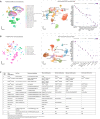Harmonized cross-species cell atlases of trigeminal and dorsal root ganglia
- PMID: 38905344
- PMCID: PMC11804847
- DOI: 10.1126/sciadv.adj9173
Harmonized cross-species cell atlases of trigeminal and dorsal root ganglia
Erratum in
-
Erratum for the Research Resource: "Harmonized cross-species cell atlases of trigeminal and dorsal root ganglia" by S. Bhuiyan et al.Sci Adv. 2024 Dec 6;10(49):eadt4792. doi: 10.1126/sciadv.adt4792. Epub 2024 Dec 6. Sci Adv. 2024. PMID: 39642234 Free PMC article. No abstract available.
Abstract
Sensory neurons in the dorsal root ganglion (DRG) and trigeminal ganglion (TG) are specialized to detect and transduce diverse environmental stimuli to the central nervous system. Single-cell RNA sequencing has provided insights into the diversity of sensory ganglia cell types in rodents, nonhuman primates, and humans, but it remains difficult to compare cell types across studies and species. We thus constructed harmonized atlases of the DRG and TG that describe and facilitate comparison of 18 neuronal and 11 non-neuronal cell types across six species and 31 datasets. We then performed single-cell/nucleus RNA sequencing of DRG from both human and the highly regenerative axolotl and found that the harmonized atlas also improves cell type annotation, particularly of sparse neuronal subtypes. We observed that the transcriptomes of sensory neuron subtypes are broadly similar across vertebrates, but the expression of functionally important neuropeptides and channels can vary notably. The resources presented here can guide future studies in comparative transcriptomics, simplify cell-type nomenclature differences across studies, and help prioritize targets for future analgesic development.
Figures





Update of
-
Harmonized cross-species cell atlases of trigeminal and dorsal root ganglia.bioRxiv [Preprint]. 2023 Jul 5:2023.07.04.547740. doi: 10.1101/2023.07.04.547740. bioRxiv. 2023. Update in: Sci Adv. 2024 Jun 21;10(25):eadj9173. doi: 10.1126/sciadv.adj9173. PMID: 37461736 Free PMC article. Updated. Preprint.
References
-
- Usoskin D., Furlan A., Islam S., Abdo H., Lönnerberg P., Lou D., Hjerling-Leffler J., Haeggström J., Kharchenko O., Kharchenko P. V., Linnarsson S., Ernfors P., Unbiased classification of sensory neuron types by large-scale single-cell RNA sequencing. Nat. Neurosci. 18, 145–153 (2015). - PubMed
-
- Wang K., Cai B., Song Y., Chen Y., Zhang X., Somatosensory neuron types and their neural networks as revealed via single-cell transcriptomics. Trends Neurosci. 46, 654–666 (2023). - PubMed
Publication types
MeSH terms
Grants and funding
LinkOut - more resources
Full Text Sources
Miscellaneous

